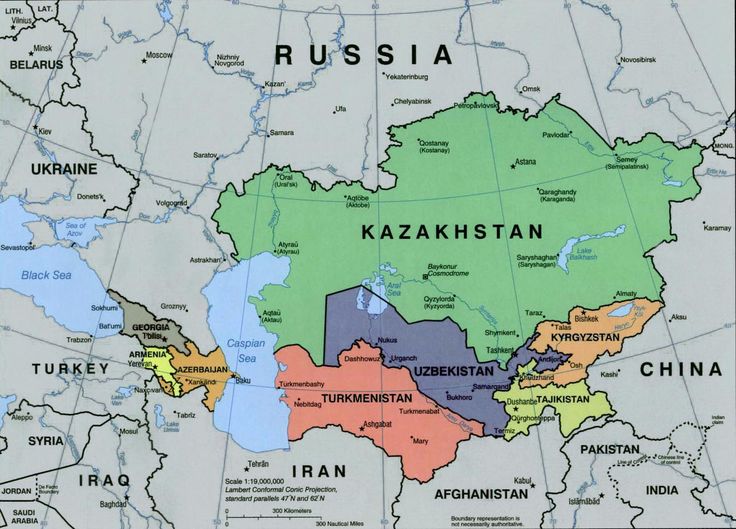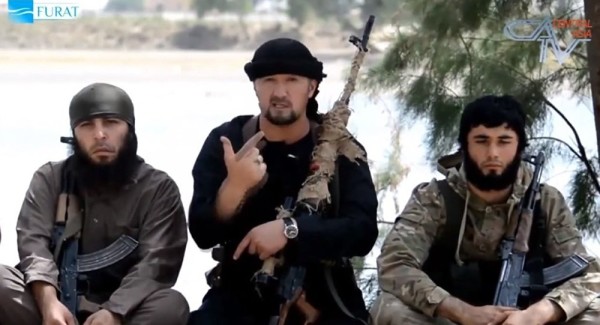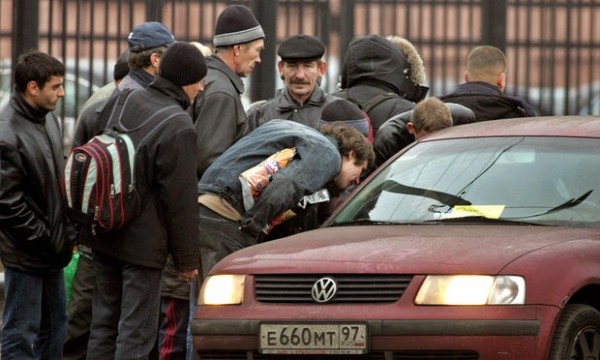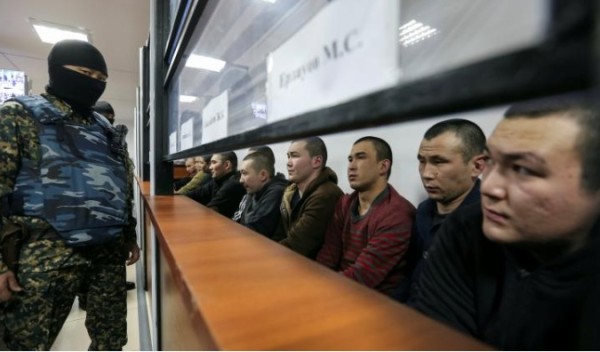MANTRAYA SPECIAL REPORT#11: 28 JUNE 2017
Islamic State in Central Asia
–
Bibhu Prasad Routray
–
Abstract
The Islamic State (IS) has been able to attract into its fold a substantial number of people from the Central Asian States (CAS). A number of IS-inspired attacks by nationals from the CAS continue to take place in various countries in the region as well as outside. Impetus for this dynamic is not to be found in radicalization alone, rather in escapism from poor economic conditions and repression by authoritarian regimes. State responses to the phenomenon, however, have remained off the mark. Though necessary, it is clear that more is needed than repressive measures and greater funds allocation that masquerade as stringent measures. It also seems unlikely that the defeat of IS in Iraq and Syria will mean the death of extremism in the CAS region.
–
“The Caliphate will come to Tajikistan, so that Muslims will be able to live with Allah”[1]
-Gulru, a mother of three from Tajikistan who travelled to Aleppo in 2015 along with her children and husband.
–
On New Year’s Eve of 2017, a gunman identified as Uzbek national Abdulkadir Masharipov carried out an attack in an upscale night club in the suburbs of Istanbul and killed 39 people.[2] According to reports, the attacker opened fire with an automatic rifle, throwing stun grenades to allow himself to reload and shoot the fallen on the ground. Among those killed in the attack were Turks and visitors from several Arab nations, Canada, and India. The Islamic State (IS)claimed responsibility for the attack, hailing the gunman, with the code name Abu Mohammed Khorasani Abdulkavi, as a “heroic soldier of the caliphate” who attacked the nightclub “where Christians were celebrating their pagan feast.” While Masharipov was arrested after two weeks, his facilitator, identified as Abdurrakhmon Uzbeki[3] was killed only later in an American ground operation in Syria in April 2017.[4]
This was the second big terror attack in Turkey, after the 29 June 2016 attack at the Ataturk airport, which was carried out by three attackers, a Chechen, a Kyrgyz, and an Uzbek, ostensibly trained by the IS.Forty-one people were killed and 230 were injured in that attack after the attackers arrived in a taxi and began firing at the terminal entrance. They blew themselves up after police responded.
While Turkey’s proximity to Iraq and Syria offers one explanation as to why the country is experiencing spill over from the conflict, other nations have not been insulated from IS-inspired attacks similarly executed by or including nationals from the Central Asian States (CAS). For instance, in April 2017, a driver of a hijacked beer delivery truck, identified as Rakhmat Akilov, a 39-year-old from Uzbekistan, careered into crowds on Stockholm’s largest shopping street, killing four and injuring many more. Akilov had been recruited by the IS and had been resident in Sweden since 2014.[5]In Russia, 22-year-old Akbardzon Dzhalilov, a native of Kyrgyzstan who had obtained Russian citizenship, carried out suicide terror attacks in the St. Petersburg metro on 3 April 2017, killing 15 people and injuring 45. In fact, individuals originating from the CAS appear to constitute a large chunk of the IS cadre base and thus have indeed emerged as significant potential sources of terror attacks at home as well as abroad.
The Journey
Since 2014– the five former Soviet republics: Kazakhstan, Turkmenistan, Tajikistan, Uzbekistan, and Kyrgyzstan, including the Chinese province of Xinxiang – have become prominent recruiting grounds for the Islamic State.
‘Thousands’ remains the most commonly used expression in reports describing the IS-CAS connection. In 2015, the International Crisis Group (ICG) reported that with IS were between 2,000 and 4,000 from CAS. The same year, another estimate suggested that more than 4,700 Central Asians could have joined.[6] While about half of these people are from the Russian republics of Chechnya, Ingushetia, and Dagestan, the rest are from the five CAS countries. While correct estimates are hard to come by, a 2016 estimate of Kyrgyzstan’s Ministry of Internal Affairs put more than 500 citizens of Kyrgyzstan fighting in Iraq and Syria, with more than 30 killed in combat. Kazakhstan similarly stated that around 400 Kazakhs were involved in armed conflicts in the Middle East. The highest contribution, however, came from Tajikistan, with 1,300 youths said to have joined the IS. There are no estimates for Uzbeks, but according to a report, many such CAS-origin cadres with IS in reality are Uzbeks.[7]
While a large portion of movements have been from the CAS and Russia to Iraq and Syria, the profiles of the attackers in Turkey, Russia, and Stockholm reveal that some individuals had moved out of CAS and settled in the likes of Europe, Afghanistan, and Turkey prior to their participation in terrorist attacks.The Istanbul night club attacker,Masharipov, for example was born in 1983 in Uzbekistan and educated in Afghanistan, but he had entered Turkey six months before carrying out the operation.
Available information further suggest that some women from CAS countries have travelled to Iraq and Syria with their spouses. The call of IS,which says it wants teachers, nurses and engineers, not just fighters,thus opens up a much wider canvass of possible assailants making their way abroad.
Much about these journeys has yet to be documented and hence there remains limited access to precise methodologies being used. Some insight, though comes from accounts such as that of a Kyrgyz woman who, in 2014, travelled with her husband to Syria to be a part of IS. She contacted her family only after her husband was killed. Refusing to return home, she wrote, “Please try to understand me, I live in a true Islamic country where my beliefs are accepted. I want to raise my children as true Muslims and I can do that only here. This is the duty of a true Muslim. My reward is in the afterlife. One’s parents are not as important as Allah.”[8]
The Impetus
Such deep-seated alienation from the existing order appears to undergird the flow from the CAS to the Middle East and beyond. Multiple reasons account for the trend.
Much of Central Asia was formerly part of the communist Soviet Union, which repressed the sense of identity, religion, and nationality. Once communism collapsed, and the Soviet Union disintegrated in the early 1990s, the absence of economic opportunities and withdrawal of state support created conditions for the birth of a new ideology. Young men who had been long suppressed by the state found opportunities for identity and meaning by becoming part of the existing movements espousing an Islamic caliphate.
Formation of new organizations amidst the disintegration of the Soviet Union saw the prevailing chaos facilitate still further movement into the CAS region. As a result, a large number of radical Islamist organisations have been operating in the CAS region. The East Turkestan Islamic Movement came into being 1989. Hizbut Tahrir al Islam, which had originated in 1958, expanded into the CAS in the early 1990s, while the Islamic Movement of Uzbekistan (IMU) was formed in 1998. The Jamaat of Central Asian Mujahidin originated in 2001 as a splinter of the IMU in 2001.
While their methods and strategies may have differed, most groups shared the goal of overthrowing secular yet authoritarian and corrupt regimes and establishing an Islamic state.[9] This meshed well with the romantic and potent IS “call to justice for many who have become disenchanted with the corruption and authoritarianism of Central Asia’s leaders.”[10]
IS expansion in the region thus was facilitated by some within the existing organisations declaring their allegiance to the IS, leading to splits in the parent organisation. The IMU in late 2014, for instance, underwent a split after its emir, Usman Ghazi, declared the outfit’s allegiance to the Islamic State.[11] Even when some of these organisations have held onto their alliance with the al Qaeda, their operations have prepared, in a way, the ideological base for IS to take root and recruit.
IS recruiters, present in cities across the region, have exploited this fertile ground. According to researchers, they target mostly poorer regions, suburbs, towns, areas with big bazaars, a crossroads perhaps, with a good communication network; places that allow a mixing of people anonymously. In February 2015, Kyrgyzstan’s Interior Ministry said it had uncovered 83 cases of recruiters trying to bring fighters to Syria. In May 2016, Russia arrested two Tajiks suspected of recruiting for IS and a year later sentenced them to prison terms of over six years.[12] While such narratives, especially with regard to Russian counter terrorism methods, need to be accepted with some scepticism, IS has indeed targeted migrant workers from the CAS region in Moscow’s construction sites.[13]
A notable IS recruit from Tajikistan was Colonel Gulmurod Khalimov[14], a 41-year-old U.S.-trained former police officer who had commanded OMON,an elite police unit. Khalimov left for Syria in April 2015 and in May 2016 appeared in a You Tube video “vowing to bring jihad to Russia and the United States as he brandished a cartridge belt and sniper rifle.”[15]
(Colonel Gulmurod Khalimov at the centre with two other Islamic State fighters in the You Tube Video capture)
“Listen you dogs, the president and ministers, if only you knew how many boys, our brothers are here, waiting and yearning to return to Tajikistan to re-establish sharia law there,”[16] he said, addressing Tajik President Imomali Rakhmon. In November 2016 the Tajik Interior Ministry issued an international arrest warrant for him.
Mobilisation and not radicalisation explains why the aloofness from security matters of the largely secular CAS and their brand of Islam has over time been driven to change. For many years before the IS phenomenon, with an insignificant presence of radical Islamist organisations, Islam in Central Asia remained devoid of ideological content. Islam in general and Sunni Hanafi Islam in particular posed no security threat. Over time things changed.
On the one hand, there appears to have been, among previously affluent families, a search for meaning. Although no large-scale assessment of IS supporters in the CAS is available, stories have emerged of personal journeys by Muslim men and women that have followed a particular pattern. Life has gradually changed, which for well-educated individuals belonging to families previously of means, meant searching for new structures of belonging. This showed up in the adoption of strict Arabic values before proceeding to Syria.
On the other hand, there was an economic dimension, though it is not entirely clear what role the developing economic stresses in some of the CAS played in the surge of IS-related activities. Kazakhstan’s economy, for instance, has been affected by the fall in global oil prices. Its real Gross Domestic Product (GDP) growth slowed from 1.2 percent in 2015 to 1 percent in 2016. The World Bank expects its economic growth to hover around 3 percent a year from 2017-19.[17] This has led to rare outbreaks of violence and public protests since April 2016, initially caused by discontent over proposed land reforms but swiftly attracting others unhappy about wider issues.
Tajikistan, the poorest of the CAS nations, with 8 million people, borders Afghanistan and has been run by President Rakhmon since 1992. In a civil war that lasted for six years between 1992 and 1997, he used Russian support to crush Islamist guerrillas. He now tolerates little dissent, even as life has become increasingly difficult for his countrymen.
(Casual workers from Central Asian States on a Moscow street negotiating with a potential employer,
Photo Courtesy: The Guardian)
Poverty in both Tajikistan as well as Kyrgyzistan stands at 30 percent, making life difficult for a large number of their population and making them vulnerable to extremist mobilisation. Russia’s very restrictive immigration policy, where young CAS men and women previously found employment, means many are now returning home without jobs. This has added to their personal vulnerability. Although no research appears to have been done connecting the phenomenon of joblessness, anecdotal accounts do point at the fact that “resistance in the name of Islam has proved to have had less to do with religion and more with hopelessness, despair and anger generated from oppressive and incompetent rule.”[18]
Looking at the range of types in the potential recruiting pool, certainly a straight ideological pitch will appeal to some. Khalimov and the Kyrgyz woman whose statement was quoted earlier, for instance, could have been among this group.
For the rest, experts believe economic reasons serve as a crucial entry point. A Tajik woman, whose daughter Gulru (and her three children) went to Syria in 2015 to join IS along with her husband,told The Guardian newspaper that IS “had given the family $30,000 for their journey to Aleppo. They had settled into a four-bedroom apartment with a television, refrigerator and carpets. IS also pays them $35 a month in child benefits for each of their three children.”[19]
State Response
Just how significant the perceived threat actually is remains a matter of assessment. The spectre of attack, though, has led to an increased flow of resources to the security establishments of the countries concerned. In December 2014, Uzbek then-President Islam Karimov (who died in September 2016) asked Vladimir Putin for assistance in combating the threat of extremism in the region. In January 2015, Nursultan Nazarbayev, the president of Kazakhstan, announced that he would allocate more funding to securing the country’s borders.[20]
In January 2015, IS released a video which allegedly showed a young Kazakh boy executing two men accused of being Russian spies. The same month, Uzbekistan’s domestic intelligence agency announced that it had intercepted communications indicating that IS was planning on carrying out terrorist attacks in the country.Kazakhstan, whose 18 million people are relatively well off, has been an authoritarian state ruled by President Nursultan Nazarbayev since 1989 and has experienced a number of attacks by militants suspected of links to IS. In June 2016, in the city of Aktobe, 18 attackers believed to be acting upon a call issued by Abu Muhammad al-Adnani, a senior IS leader and spokesperson, killed three military officials and five civilians.In July 2016,a gunman killed at least three policemen and two civilians in Almaty, the country’s financial capital.[21] The same month, one of the six Salafists being detained by the security forces blew himself up.
These, in addition to attacks that have taken place in Russia by CAS recruits of IS, have prepared the ground for a strong state response that serves the additional purpose of protecting the regimes against widespread, growing discontent. At least some analysts see parallels between the trajectory of IS and possible developments in CAS. On 9 June 2017, Russian President Vladimir Putin said that IS was trying to destabilise central Asia and southern Russia and called for strengthened coordination between the member states of the Shanghai Cooperation Organization (SCO).[22] Earlier, in December 2015, Emomalii Rakhmon, the president of Tajikistan, referred to IS as “the plague of the new century and a global threat.”
The return of IS fighters to their homes in fact poses a near and medium term threat to the CAS region. The phenomenon which started following the liberation of Fallujah and Manbij in Iraq and Aleppo in Syria has continued, with IS steadily losing the territory under its control. The result is a steady return of IS veterans to their homelands. And the adopting of hard-line approaches by individual CAS countries seeks to make such return journeys difficult.
(Islamic State supporters, who attacked a National Guard facility in June 2016, sit inside a glass-walled cage during a verdict hearing at a court in Aktobe, Kazakhstan, in November 2016. Photo Courtesy: REUTERS)
Not only have there been instances of individuals arrested upon return, even journalists investigating the story have been persecuted. In June 2016, for instance, Kyrgyzistan detained three people who had fought in Syria and returned home. They were charged with intending to create an IS underground cell to carry out attacks. While Tajikistan does have an amnesty scheme for people surrendering voluntarily to the authorities, the unknown implications of such declaration could serve as a deterrent on potential returnees. In July 2016, the country sentenced two persons – Dilafruz Kholov and Izzatullo Fuzailov – to 10-year prison terms after charging them with attempts to kill the President.
Tajik authorities have also used the IS threat to repress domestic opposition. The Islamic Renaissance Party of Tajikistan (IRPT) has been accused by the government of having connections with IS, and in 2015, the Tajik Supreme Court banned the party. Its top leaders were sentenced to long prison terms after a closed-door trial. The country’s most restrictive measures on religion also include shuttering dozens of mosques across the country, fining women for wearing the hijab, and banning parents from giving their children Arabic names. Tajik police even have gone to the extent of forcibly shaving off the beards of some 13,000 men, according to the Human Rights Watch.[23] Virtually outlawing of political opposition and cracking down on all forms of Islam, Tajikistan could have indeed created ideal conditions for the IS and other extremist ideologies to spread.
Such conflicted measures, fighting IS while simultaneously seeking regimes survival, highlight that the CAS remain largely unprepared to deal with the threat of violent radical Islamism. It is almost a truism to observe that effective response must begin with reform at home. Socio-economic transformations, anti-corruption measures, and more professional law enforcement must accompany more blunt measures to fight IS. In the CAS, unfortunately, the chances of this happening are slim.
–
End Notes
[1] Daniil Turovsky, “How Isis is recruiting migrant workers in Moscow to join the fighting in Syria”, Guardian, 5 may 2015, https://www.theguardian.com/world/2015/may/05/isis-russia-syria-islamic-extremism. Accessed 24 June 2017.
[2] Zia Weise, “Istanbul nightclub attack: Man suspected of killing 39 in New Year’s Eve massacre captured by police”, Telegraph, 17 January 2017, http://www.telegraph.co.uk/news/2017/01/16/istanbul-nightclub-attacker-killed-39-new-years-eve-nightclub/. Accessed 20 June 2017.
[3] Eric Schmitt, “Commando raids on ISIS yield vital data in shadowy war”, New York Times, 25 June 2017, https://www.nytimes.com/2017/06/25/world/middleeast/islamic-state-syria-raqqa-special-operations.html. Accessed 27 June 2017. Accessed 27 June 2017.
[4]“U.S. forces kill Islamic State militant linked to Turkey nightclub attack”, Reuters, 21 April 2017, http://www.reuters.com/article/us-mideast-crisis-usa-uzbeki-idUSKBN17N2AJ. Accessed 20 June 2017.
[5] Chantal Da Silva, “Stockholm attack: Uzbekistan says it had warned West about suspect”, Independent, 4 April 2017, http://www.independent.co.uk/news/world/europe/stockholm-terror-attack-uzbekistan-warned-suspect-rakhmat-akilov-a7683631.html. Accessed 21 June 2017.
[6] “Foreign Fighters”, The Soufan Group, December 2015, http://soufangroup.com/wp-content/uploads/2015/12/TSG_ForeignFightersUpdate3.pdf. Accessed 21 June 2017.
[7] In 2015, a representative of Kyrgyzstan’s Secretariat of the Council of Defense claimed that more than 70 percent of the Kyrgyz that have gone to join the IS are of Uzbek descent.
[8] Luca Bello, “A Kyrgyz Family in the Islamic State”, Diplomat, 21 April 2015, http://thediplomat.com/2015/04/a-kyrgyz-family-in-the-islamic-state/. Accessed 21 June 2017.
[9] ZeynoBaran, “Radical Islamists in Central Asia”, Hudson Institute, 12 September 2015, https://hudson.org/research/9830-radical-islamists-in-central-asia. Accessed 24 June 2017.
[10] Reid Standish, “Shadow Boxing With the Islamic State in Central Asia”, Foreign Policy, 6 February 2015, http://foreignpolicy.com/2015/02/06/shadow-boxing-with-the-islamic-state-in-central-asia-isis-terrorism/. Accessed 24 June 2017.
[11] In June 2016, a new faction of the IMU emerged indicating that it remains loyal to the Taliban, al Qaeda, and other traditional jihadist groups that operate in Pakistan, Afghanistan, and Central Asia.
[12] “Two ISIS recruiters from Tajikistan receive prison sentences in Russia”, RAPSI News, 23 May 2017, http://www.rapsinews.com/judicial_news/20170523/278685905.html. Accessed 25 June 2017.
[13] Daniil Turovsky, “How Isis is recruiting migrant workers in Moscow to join the fighting in Syria”, n.1.
[14] Some publications refer to him as Gulmurod Chalimow.
[15] Dmitry Solovyov, “Commander of elite Tajik police force defects to Islamic State”, Reuters, 28 May 2015, http://www.reuters.com/article/us-mideast-crisis-tajikistan-idUSKBN0OD1AP20150528. Accessed 24 June 2017.
[16] ibid.
[17] “Kazakhstan’s Economy Has Bottomed Out, Now Searching for New Sources of Growth”, The Financial, 16 May 2017, https://www.finchannel.com/business/64921-kazakhstan-s-economy-has-bottomed-out-now-searching-for-new-sources-of-growth. Accessed 14 June 2017.
[18] Dana E. Abizaid, “Why ISIS Recruits from Uzbekistan and Kyrgyzstan”, National Interest, 16 January 2017, http://nationalinterest.org/feature/why-isis-recruits-uzbekistan-kyrgyzstan-19067. Accessed 14 June 2017
[19] Daniil Turovsky, “How Isis is recruiting migrant workers in Moscow to join the fighting in Syria”, n.1.
[20] Uran Botobekov, “Is Central Asia Ready to Face ISIS?”, Diplomat, 8 July 2016, http://thediplomat.com/2016/07/is-central-asia-ready-to-face-isis/. Accessed 11 June 2017.
[21] Mariya Gordeyeva and Olzhas Auyezov, “Suspected Islamist militant kills five in Kazakhstan”, Reuters, 18 July 2016, https://www.yahoo.com/news/shooting-heard-near-police-station-kazakh-city-almaty-055718240.html. Accessed 11 June 2017.
[22] “Putin warns IS plans to destabilize southern Russia and Central Asia”, TASS, 9 June 2017, http://tass.com/politics/950688. Accessed 11 June 2017.
[23] Steve Swerdlow, “Tajikistan’s fight against political Islam”, Human Rights Watch, 15 March 2016, https://www.hrw.org/news/2016/03/15/tajikistans-fight-against-political-islam. Accessed 28 June 2017.
(Bibhu Prasad Routray is Director, Mantraya. This Special Report is published as part of Mantraya.org’s ongoing “Islamic State in Asia” and “Mapping Terror and Insurgent Network” projects. Mantraya Special Reports are per reviewed publications.)
To download a PDF version of this special report click here: Islamic State in Central Asia
To Read previous Special Reports, CLICK HERE






